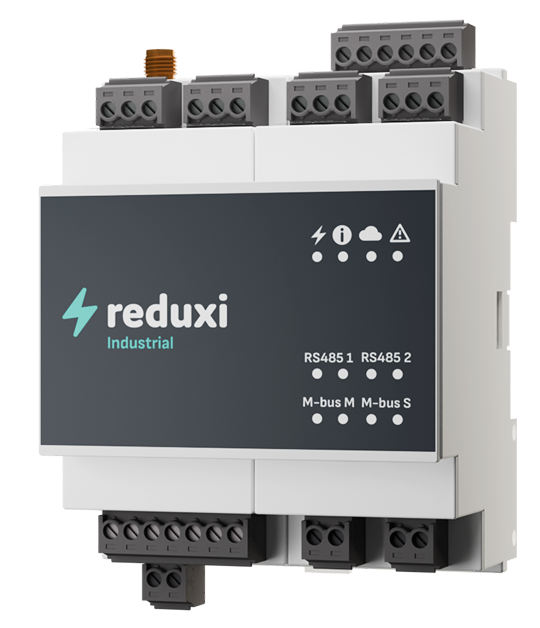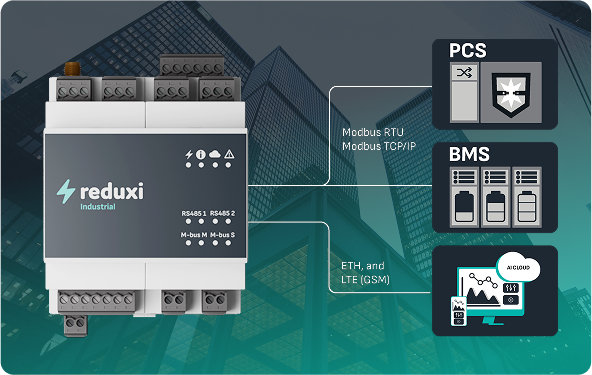Reduxi Controller BESS-ohjaimena ja EMS-järjestelmänä
Älykäs BESS-hallintajärjestelmä ja kattava EMS-järjestelmä yhdessä

Avaa uusi integraation ja hallinnan taso Reduxi Industrial -ohjaimella. Tehokkaan energianhallintajärjestelmän (EMS) ominaisuuksiensa lisäksi Reduxi Industrial -ohjain voi toimia myös akkuenergian varastointijärjestelmän (BESS) keskeisenä koordinoivana linkkinä. Se saavuttaa tämän hallitsemalla asiantuntevasti tiedonsiirtoa ja toiminnallista synergiaa akun oman kriittisen akunhallintajärjestelmän (BMS) ja valitsemasi tehonmuuntojärjestelmän (PCS) välillä.
Ajattele asiaa näin: akun BMS on keskeinen älykkyysosasto, joka suojaa akkua ja valvoo sen kuntoa, varaustilaa ja toimintarajoja. Reduxi Industrial -ohjain on yhteydessä tähän BMS:ään, ottaa vastaan sen elintärkeät tiedot ja ohjeet ja antaa sitten älykkään komennon PCS:lle. Tämä on samanlaista kuin se, miten erityiset ESS-ohjaimet huolehtivat energiavarastojärjestelmän sisäisten toimintojen hienostuneesta hallinnasta. Reduxi Industrial -ohjain täyttää tehokkaasti tämän tärkeän roolin ja varmistaa, että akku ja PCS toimivat harmonisesti yhdessä tehokkaan latauksen, purkauksen ja BESS:n kokonaissuorituskyvyn varmistamiseksi.
Reduxi-etu: Yhtenäinen BESS-ohjaus ja kokonaisvaltainen energianhallinta.
Reduxi Industrial -ohjain erottuu edukseen, koska se pystyy ainutlaatuisella tavalla yhdistämään yksityiskohtaisen BESS-koordinoinnin (BMS to PCS) ja laajemman toiminnon kattavana energianhallintajärjestelmänä (EMS).
Tämä tarkoittaa, että Reduxi Industrial -ohjain ei ainoastaan varmista, että akku (sen BMS:n kautta) ja PCS toimivat optimaalisesti yhtenäisenä BESS-yksikkönä, vaan se myös integroi saumattomasti BESS-yksikön ja hallitsee sitä älykkäästi yhdessä kaikkien muiden energiavarojen kanssa.
Reduxi Industrial -ohjain toimii sekä täsmällisenä ESS-koordinaattorina (akun BMS:n ja PCS:n välisenä rajapintana) että yleisenä EMS-järjestelmänä, joten se tarjoaa virtaviivaisen ja tehokkaan ratkaisun. Se mahdollistaa aidosti kokonaisvaltaisen energiaoptimoinnin ja varmistaa, että itse tuotettua sähköä, varastoitua energiaa ja kulutusta hallitaan tehokkaimmalla ja kustannustehokkaimmalla tavalla koko ekosysteemissä. Tämä integroitu lähestymistapa yksinkertaistaa järjestelmäarkkitehtuuria ja maksimoi samalla energiaomavaraisuutesi ja -säästösi.
Yleiskatsaus Reduxi Industrial -ohjaimen toimintoihin:
BMS:n integrointi PCS:ään
Toimii suorana tiedonsiirtoyhteytenä akunhallintajärjestelmän (BMS) ja tehonmuuntojärjestelmien (PCS/invertterit) välillä ja varmistaa synkronoidun toiminnan.
Tukee eri viestintäkerroksia, kuten Modbus TCP, Modbus RTU, jotka perustuvat omaan tai SunSpec-protokollaan, kun eri BMS-valmistajan ja eri PCS-valmistajan (esim. KACO, Sinexcell, Kehua, CATL, Sineng jne.) integrointiin.
Käytetään kaupallisissa tai teollisissa järjestelmissä tai yleishyödyllisissä järjestelmissä.
BESSin ohjaus ja optimointi
Sinun Mahdollistaa kaksisuuntaisen viestinnän BMS:n ja PCS:n välillä ESS:n lataamisen ja purkamisen mahdollistamiseksi.
Valvoo BMS-tietoja (lataustila/terveystila, jännitteet, virrat, energia jne.).
Toteuttaa huipun säästämisen, kuorman siirtämisen ja taajuuden säätämisen ilman kolmannen osapuolen ohjelmistoa.
Monen omaisuuserän EMS-ominaisuudet
Koordinoi BESS + aurinko + EV-laturit yhdellä alustalla:
- Asettaa aurinkoenergian omakäytön etusijalle ja hallitsee samalla akkujen jaksoja.
- Aikatauluttaa sähköautojen latauksen matalan tariffin aikoina käyttämällä ylimääräistä aurinkoenergiaa tai varastoitua energiaa.
- Tasapainottaa verkon tuontia/vientiä markkinahintojen ja verkon rajoitusten perusteella.
- Säätää dynaamisesti lataus-/purkaussyklejä reaaliaikaisten verkko-olosuhteiden, SPOT-markkinoiden (Day-Ahead, Intra-Day), tasehallintapalveluiden ja akun kunnon mittaamisen (SOC, lämpötila jne.) perusteella.
Reduxi Industrial controller edut:
Miten Reduxi vertautuu perinteisiin ratkaisuihin?
Reduxi Industrial -ohjain toimii sekä täsmällisenä ESS-koordinaattorina (akun BMS:n ja PCS:n välisenä rajapintana) että yleisenä EMS-järjestelmänä, joten se tarjoaa virtaviivaisen ja tehokkaan ratkaisun. Se mahdollistaa aidosti kokonaisvaltaisen energiaoptimoinnin ja varmistaa, että itse tuotettua sähköä, varastoitua energiaa ja kulutusta hallitaan tehokkaimmalla ja kustannustehokkaimmalla tavalla koko ekosysteemissä. Tämä integroitu lähestymistapa yksinkertaistaa järjestelmäarkkitehtuuria ja maksimoi samalla energiaomavaraisuutesi ja -säästösi.
| Reduxi Industrial Controller | BESS-vakiosäätimet | |
|---|---|---|
| Integrointi | BESS + aurinko + EV + sähköverkko | Pelkkä BESS tai rajoitettu omaisuuserätuki |
| BMS-viestintä | Suora integrointi BMS:n kanssa (Modbus TCP, Modbus RTU). | Vaatii usein väliohjelmiston |
| PCS-viestintä | Suora integrointi PCS:n kanssa (Modbus TCP, Modbus RTU). | Vaatii usein väliohjelmiston |
| Muu viestintä | ETH WAN+LAN, 2x RS485, 6x digitaalinen tulo, 4x releportti, M-Bus Master, M-Bus Slave, LTE | Usein vain 1x ETH |
| Tekoälyn optimointi | Sisäänrakennettu koneoppiminen mukautuvia strategioita varten | Vain sääntöpohjainen automaatio |
| Monimerkkituki | Toimii useimpien BMS/PCS-merkkien kanssa (lisäintegraatiot mahdollisia). | Myyjään sidotut järjestelmät |
Miksi valita Reduxi?
Kustannustehokkuus: Korvaa erilliset ESS-ohjaimet ja EMS-alustat.
Tulevaisuuden kestävä: Modulaarinen rakenne tukee uusia resursseja.
Tulojen pinoaminen: Yhdistää erilaisia palveluja, tarjoaa SPOT-optimointia (Day-Ahead, Intra-Day), lisäpalveluja ja kysyntäjoustoa.
Turvallisuus / EU:n vaatimustenmukaisuus: Reduxi Industrial controller on asiaankuuluvien turvallisuus- ja vaatimustenmukaisuusstandardien (EMC, Safety, RED ...) mukainen, ja WAN/LAN-arkkitehtuurinsa ansiosta se voi toimia palomuurina BMS:n tai PCS:n ja valmistajan taustajärjestelmän/pilven välillä, jolloin voit 100% hallita BESS-järjestelmääsi.

Helppo integrointi eri BMS- (akku-) ja PCS-järjestelmien kanssa Modbus TCP:n tai RTU:n kautta, jolloin voit vapautua valmistajalukosta ja käyttää erilaisia BMS- ja PCS-valmistajien yhdistelmiä.
EMS:n valvonta ja seuranta kaikkien järjestelmään kuuluvien laitteiden, kuten aurinkoenergian, sähköautojen latureiden, lämpöpumppujen ja verkkomittareiden, saumaton integrointi BESS:n kanssa yhdeksi järjestelmäksi.
Erilaiset strategiat BESS:n käyttöä varten (yhdistettynä muihin järjestelmässä oleviin laitteisiin), mukaan lukien huippupäästöjen vähentäminen/siirtäminen, verkon säätö (joustavuus), kysyntä/vastaus, ToU ja Day ahead dynaamiset tariffit....
Suora yhteys verkkomittariin tuottaa reaaliaikaista tietoa järjestelmän ohjausta varten ja mahdollistaa erilaisten ohjausstrategioiden ja verkkopalvelujen käytön.
Etävalvonta ja -ohjaus yleiskatsaus järjestelmään ja sen laitteisiin sovelluksessa tai verkossa, ja mahdollisuus ohjata laitteita suoraan järjestelmässä.